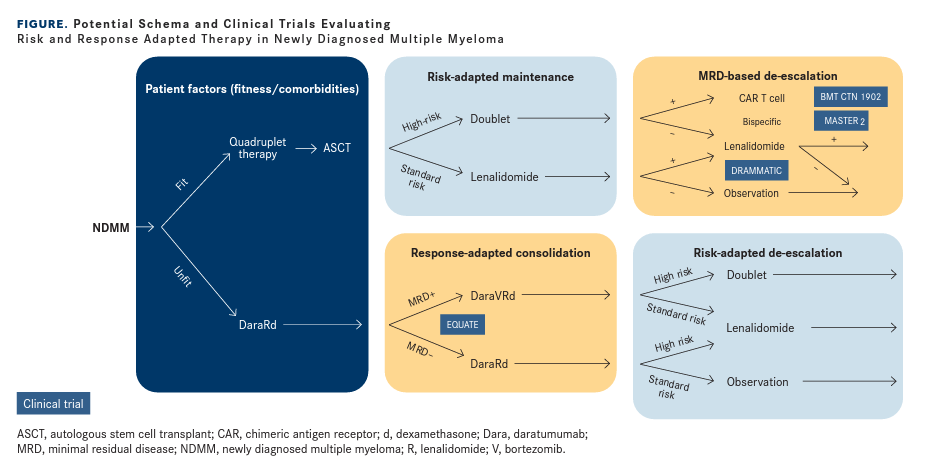Publication
Article
Oncology Live®
Risk- and Response-Adaptive Strategies Illuminate New Directions for Multiple Myeloma
Although cytogenetic abnormalities have helped to characterize prognosis and identify patients who are at high risk of early progression, risk stratification has little effect on management decisions for most patients with multiple myeloma.
Timothy Schmidt, MD

Multiple myeloma is characterized by dramatic heterogeneity with regard to its clinical manifestations, severity, genomic landscape, and outcomes. Despite this heterogeneity, the current treatment paradigm for patients with multiple myeloma is essentially a one-size-fits-all approach. In general, treatment decisions are primarily based on patient-specific factors such as age, comorbidities, and response to prior treatment, rather than disease-specific factors such as driver mutations, staging, and risk stratification. Although cytogenetic abnormalities have helped to characterize prognosis and identify patients who are at high risk of early progression, risk stratification has little effect on management decisions for most patients with multiple myeloma.
The vast majority of patients receive initial therapy with lenalidomide (R; Revlimid), bortezomib (V; Velcade), and dexamethasone (d), with consolidative autologous stem cell transplant (ASCT) for fit patients, followed by continuous maintenance therapy. Although many patients with MM achieve many years—sometimes decades—of survival with standard first-line therapy, others experience early progression in spite of aggressive management. Based on marked variability in outcomes, the standard of care of continuous therapy until progression for all patients with MM is now being challenged in 2 very different ways.
Risk-Adapted Therapy
For patients with high-risk disease who are able to tolerate more aggressive therapy, the concept of risk-adapted therapy has been an active area of investigation. Although lenalidomide maintenance has shown to improve outcomes for almost all subgroups after ASCT, patients with high-risk disease derive less benefit, leading some to advocate for a more aggressive approach in high-risk patients. The addition of a proteasome inhibitor (PI) to maintenance therapy has been proposed for high-risk patients based on the fact that bortezomib maintenance has been demonstrated to improve progression-free survival (PFS) in patients with high-risk cytogenetics.1,2
In a single-center study, the use of extended-duration RVd maintenance after transplant among high-risk patients resulted in survival rates far higher than expected in this population.3 In the phase 2 FORTE study (NCT02203643), a second randomization evaluated the effect of adding biweekly carfilzomib (K; Kyprolis) to lenalidomide maintenance, and found that KR maintenance improved PFS compared with lenalidomide among all patients, including those with high-risk cytogenetics, except for those with amplification of 1q.4
Although improvement in PFS is certainly a requirement when considering maintenance therapy, it is critical to remember that patients receiving maintenance therapy are largely in remission and that the patient experience and quality of life must remain paramount, particularly if no overall survival benefit has been proven. For patients at high risk of progression, whose disease may be more difficult to control with subsequent therapies, the PFS benefit of doublet maintenance may be worthwhile. However, the burden and toxicity of adding a PI to maintenance may be undesirable in most standard-risk patients, who often achieve a durable remission with standard approaches. Furthermore, based on emerging data for the profound efficacy of quadruplet induction regimens, many patients—especially those with standard-risk disease—may be eligible for an alternative strategy.
Response-Adapted Therapy
The eradication of minimal (or measurable) residual disease (MRD) is a powerful prognostic factor in multiple myeloma. The presence of MRD after initial therapy has consistently demonstrated superiority over staging and cytogenetic risk in terms of discriminating outcomes in patients with newly diagnosed myeloma.5-7 In fact, patients achieving sustained MRD negativity at a depth of 10-6 have an extremely low risk of progression, even with high-risk cytogenetics.8 In a study examining the efficacy of ASCT with VRd induction and 1 year of lenalidomide maintenance, more than 50% of patients with undetectable MRD at a depth of 10-6 remained without progression 6 years after discontinuing maintenance therapy.5
It remains unknown whether the achievement of MRD negativity truly changes disease biology and offers the prospect of functional cure, or if it is simply a surrogate for disease that is highly sensitive to standard therapies. Regardless, these outcomes data beg the question of whether indefinite maintenance is still required for patients with sustained MRD negativity.
MASTER (NCT03224507) was the first trial to explore the feasibility of using MRD data to inform decisions regarding whether to continue intensive therapy. In this phase 2 trial, patients were treated with daratumumab (Dara; Darzalex) plus KRd induction for 4 cycles, followed by ASCT and up to 8 additional cycles of DaraKRd consolidation. MRD assessment was performed by next-generation sequencing after induction, transplant, and each 4-cycle block of consolidation. For patients who had undetectable MRD on 2 consecutive assessments, treatment was discontinued, and patients underwent surveillance for progression or MRD resurgence, called MRD-SURE.
At the final data analysis for efficacy, 80% of patients in this study (n = 123) achieved MRD negativity at a depth of 10-5, and 71% of patients entered MRD-SURE. Investigators reported an extremely low risk of progression and/or MRD resurgence among patients with either 0 or 1 high-risk cytogenetic abnormality, with a cumulative incidence of relapse or MRD resurgence of less than 5% at 12 months, compared with 27% among patients with 2 or more high-risk cytogenetic abnormalities with this strategy.9 Overall, these data provide a strong rationale for a response-adapted de-escalation strategy for patients with 0 or 1 high-risk cytogenetic abnormality who achieve sustained MRD negativity after intensive therapy. Further, these data urge caution for this strategy among patients with very high-risk disease and signal that alternative strategies may be necessary to overcome poor outcomes in this population.
An Emerging Paradigm Shift
Ultimately, randomized, controlled studies will be necessary to clearly demonstrate the superiority of response-adapted therapy to continuous therapy. Fortunately, there are now several large, randomized studies evaluating responseadapted therapy.
In the SWOG S1803 study (DRAMMATIC; NCT04071457), following randomization to R vs Dara-R maintenance for 2 years, patients who achieve MRD negativity will be randomized to continue or discontinue maintenance, with a primary end point of overall survival.
The ECOG EAA181 trial (EQUATE; NCT04566328) is a large randomized trial evaluating response-adapted therapy in the nontransplant setting, specifically whether the use of quadruplet therapy can be reserved for cases in which initial therapy with DaraRd does not result in MRD negativity.
At the University of Wisconsin (UW), our clinical research team is focused on generating high-quality data to help determine whether management decisions in multiple myeloma can be based on disease-related factors, thereby increasing the likelihood of long-term disease control and quality of life for patients. One hallmark of this is participation in clinical trials, such as MASTER, DRAMMATIC, EQUATE, and additional investigator-initiated studies, to evaluate risk and response-adapted strategies.
Proper risk stratification is also critical for successful implementation of a risk/response adapted approach to newly diagnosed myeloma. This includes identifying nontraditional risk factors such as gain of chromosome 1q10 and/or incorporating newer genomic techniques such as whole-exome sequencing and gene expression profiling, the results of which may provide additional prognostic or predictive information. A proposed model of risk- and response-adapted therapy, with key ongoing or upcoming clinical trials at the UW Carbone Cancer Center to evaluate these approaches, is shown in the Figure. Through collaborative efforts to identify risk factors, other biomarkers of outcomes, and targeted therapies, a risk and response-based model of care in multiple myeloma is possible and offers the potential for longer and better lives for patients with multiple myeloma.

References
- Neben K, Lokhorst HM, Jauch A, et al. Administration of bortezomib before and after autologous stem cell transplantation improves outcome in multiple myeloma patients with deletion 17p. Blood. 2012;119(4):940-948. doi:10.1182/blood-2011-09-379164
- Chakraborty R, Muchtar E, Kumar SK, et al. Outcomes of maintenance therapy with lenalidomide or bortezomib in multiple myeloma in the setting of early autologous stem cell transplantation. Leukemia. 2018;32(3):712-718. doi:10.1038/leu.2017.256
- Nooka AK, Kaufman JL, Muppidi S, et al. Consolidation and maintenance therapy with lenalidomide, bortezomib and dexamethasone (RVD) in high-risk myeloma patients. Leukemia. 2014;28(3):690-693. doi:10.1038/leu.2013.335
- Gay F, Musto P, Scalabrini DR, et al. Survival analysis of newly diagnosed transplant-eligible multiple myeloma patients in the randomized Forte trial. Blood. 2020;136(suppl 1):35-37. doi:10.1182/ blood-2020-136907
- Perrot A, Lauwers-Cances V, Corre J, et al. Minimal residual disease negativity using deep sequencing is a major prognostic factor in multiple myeloma. Blood. 2018;132(23):2456-2464. doi:10.1182/ blood-2018-06-858613
- Munshi NC, Avet-Loiseau H, Anderson KC, et al. A large meta-analysis establishes the role of MRD negativity in long-term survival outcomes in patients with multiple myeloma. Blood Adv. 2020;4(23):5988-5999. doi:10.1182/bloodadvances.2020002827
- Paiva B, Puig N, Cedena MT, et al; GEM (Grupo Español de Mieloma)/ PETHEMA (Programa Para el Estudio de la Terapéutica en Hemopatías Malignas) Cooperative Study Group. Measurable residual disease by next-generation flow cytometry in multiple myeloma. J Clin Oncol. 2020;38(8):784-792. doi:10.1200/JCO.19.01231
- Goicoechea I, Puig N, Cedena MT, et al. Deep MRD profiling defines outcome and unveils different modes of treatment resistance in standard- and high-risk myeloma. Blood. 2021;137(1):49-60. doi:10.1182/ blood.2020006731
- Costa LJ, Chhabra S, Medvedova E, et al. Daratumumab, carfilzomib, lenalidomide, and dexamethasone with minimal residual disease response-adapted therapy in newly diagnosed multiple myeloma. J Clin Oncol. Published online December 13, 2021. doi:10.1200/JCO.21.01935
- Schmidt TM, Fonseca R, Usmani SZ. Chromosome 1q21 abnormalities in multiple myeloma. Blood Cancer J. 2021;11(4):83. doi:10.1038/s41408-021-00474-8





















%20(2)%201-Recovered-Recovered-Recovered-Recovered-Recovered-Recovered-Recovered-Recovered-Recovered-Recovered-Recovered-Recovered-Recovered-Recovered-Recovered-Recovered-Recovered.jpg?fit=crop&auto=format)
%20(2)%201-Recovered-Recovered-Recovered-Recovered-Recovered-Recovered-Recovered-Recovered-Recovered-Recovered-Recovered-Recovered-Recovered-Recovered-Recovered-Recovered-Recovered.jpg?fit=crop&auto=format)
